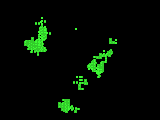 This is an animation of our simulation of a hysteresis loop. Each
frame of the animation represents 1% of the domains of the system.
Notice that the avalanches start out tiny, get large, and then get small again.
This is an animation of our simulation of a hysteresis loop. Each
frame of the animation represents 1% of the domains of the system.
Notice that the avalanches start out tiny, get large, and then get small again.
In shape-memory alloys, the shape transformation of small domains can produce crackling noises (called acoustic emission). In magnetic materials, the reorientation of the local magnetization can produce magnetic noise, called Barkhausen noise: this can be picked up and put on a loudspeaker. Thus the hysteresis loop, which looks smooth at first glance, is really composed of lots of tiny jumps.
Our group is studying the the origins of this noise. We believe that you aren't hearing the individual, microscopic domains transforming: the crackling noises are large avalanches of domains. The little domains can be pushed over the edge by the external field or by the connections with their neighbors: as the field increases, one domain transforms, triggering some of its neighbors, who kick over some of their neighbors... Some experiments (liquid Helium getting pushed into and out of tiny pores in plastic, for example) measure avalanches made up of millions of individual domains. The noise in hysteresis is the popping sounds made by this cascade of avalanches.
 This is an animation of our simulation of a hysteresis loop. Each
frame of the animation represents 1% of the domains of the system.
Notice that the avalanches start out tiny, get large, and then get small again.
This is an animation of our simulation of a hysteresis loop. Each
frame of the animation represents 1% of the domains of the system.
Notice that the avalanches start out tiny, get large, and then get small again.
This is a simulation of a hypothetical two-dimensional material (say, a magnetic tape).
One might worry that this process could go out of control: why does the avalanche stop after a million spins, rather than transforming the whole block of material in one infinite avalanche? On the other hand, if the domains aren't connected strongly, why wouldn't the avalanche peter out at small sizes? Indeed, we think that this does happen. Many kinds of systems transform in one big jump: you can supercool water before it freezes (the water to ice transition has hysteresis), but once a seed forms (if the system is kept at constant temperature) the whole container can freeze in one event.
 This shows the hysteresis loop as we go from a smooth hysteresis
loop to one with a big jump. The inset gives a plot of the likelihood
of having an avalanche of a size S.
This shows the hysteresis loop as we go from a smooth hysteresis
loop to one with a big jump. The inset gives a plot of the likelihood
of having an avalanche of a size S.
Our theories have a parameter, R, which measures the randomness relative to the strength of the connections between domains. If the randomness is large compared to the coupling, the hysteresis overall is smooth, with only small jumps (as shown at R=2.6); if the randomness is small, one infinite avalanche transforms most of the system (R=2). There is a special point, slightly lower than the point R=2.3 shown, where our theoretical model changes from smooth to abrupt.
This is an animation of the shape of the hysteresis loop as the randomness is changed from large to small. Notice that the smooth hysteresis loop develops a step as the randomness decreases.
This is a blowup of the region near the step.
For big randomness, not many avalanches get large: the inset to the figure shows the probability D that a domain will participate in an avalanche of size S. At randomness R=4, avalanches peter out after about size 100; at 2.7, one gets avalanches of size 10000. Really large avalanches only happen near the special point where infinite avalanches become possible. Our theories predict that at this point, there will be avalanches of all size scales, with a power-law distribution. The way the inset to the figure is plotted, our prediction would be a straight line: beautifully confirmed by the data at R=2.3!
Shown above is the biggest avalanche in our simulation, viewed from different angles. Notice the tenuous, swiss cheese shape. Another prediction of our theory is that, at this special point where the shape of the hysteresis changes, the big avalanches should have holes and branches of all size scales. Because the randomness is just small enough to allow the avalanche to grow big, the network of domains that is triggered in a big avalanche should have lots of places where the avalanche almost peters out, and then gets big again. This kind of network is usually called ``fractal'', although the renormalization group tools we use to understand how and why these structures form were developed earlier and quite independently of the more qualitative theories associated with fractals.
References
More information:
This research was paid for by YOUR FEDERAL GOVERNMENT through the Department of Energy (DOE #DE-FG02-88-ER45364), and through the support of the Cornell Theory Center.
![]() Jim Sethna, sethna@lassp.cornell.edu
Jim Sethna, sethna@lassp.cornell.edu
![]() Statistical Mechanics: Entropy, Order Parameters, and Complexity,
now available at
Oxford University Press
(USA,
Europe).
Statistical Mechanics: Entropy, Order Parameters, and Complexity,
now available at
Oxford University Press
(USA,
Europe).